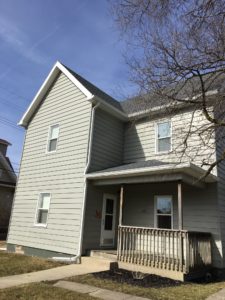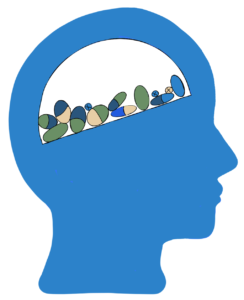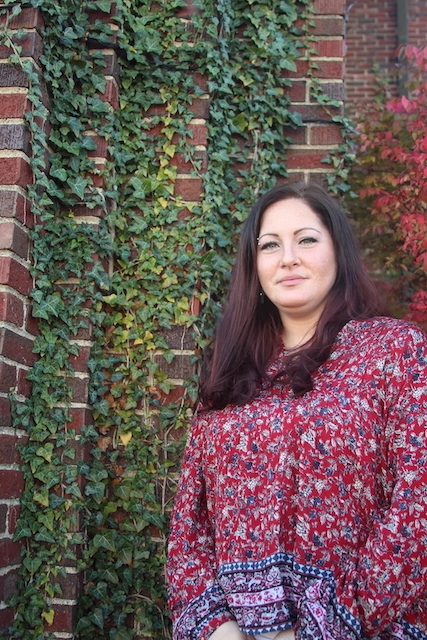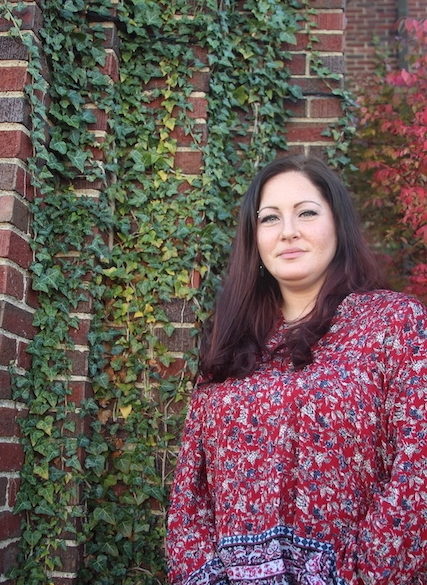Emily Jamison shares her struggles with addiction and how she learned to make a local women’s recovery center a home.
Content Warning: This story discusses substance abuse that may be triggering to some. Please read with caution.
The very first time Emily Jamison used any type of drug was when she smoked marijuana at 12 years old. She didn’t know anything about it, other than the fact that you were supposed to smoke it. So, after school, her and her best friend at the time did just that. They didn’t have any rolling papers, but that wasn’t an issue. They rolled it in regular notebook paper and lit up.
From that moment forward, Emily was consistently using some sort of drug. The drug that she was addicted to varied throughout the years. She started off smoking marijuana, then popping opioids, and then injecting meth. She was drawn to opioids and meth for an array of reasons — one of the main reasons being accessibility. She would consume whatever drugs the people around her were doing.
Emily switched from opioids to meth because she got “scared off.” The issue Emily ran into with opioids was that if she was in front of anyone, they could tell she was high and having “a lot of problems.” The main issue was Emily nodding out. This means that she would be sedated enough to the point that she would lose consciousness. She would go from feeling alert but sleepy, to falling into such a deep sleep that she couldn’t be forced to wake up. With meth, that wasn’t as much of a problem—at first.
“I didn’t really discriminate [with drugs], honestly. With opioids, I managed to scrape by, even though it was barely, but when it came to meth, once I started it went downhill fast,” Emily says.
Emily explained that there were times when she was heavily using drugs, and other times where she started to improve and wean herself off of them. Though eventually her habits would catch up to her and repeat themselves — leading her to relapse. It was a vicious cycle she fought time after time to stop.
Emily’s drug abuse led to her being arrested multiple times. The first time she was arrested was in 2012 for driving under the influence because she had her son with her. Although nobody was hurt, he was still in the car, which is what made that charge a felony. Emily was then arrested in 2016 because she overdosed and her children were home, another felony charge. She had several misdemeanors in between each of these arrests. After that, she was arrested for possession charges, in 2019.
At the time of the possession charge, Emily had been homeless for two and a half years. She carried whatever she could in her backpack. There were times when she lost her items, for whatever reason, and there were times when they were stolen, and she was left with nothing.
The Delaware County Jail conducted a brief evaluation of Emily after her possession charge. Because she was homeless, she wasn’t a good candidate for house arrest or pretrial probation unless she went into a long-term facility. That is when Emily was court ordered to apply to The Lighthouse. It took her roughly a month to get accepted.
The Lighthouse is a faith-based recovery women’s home through Urban Light’s Community Development Program. It’s a residential program that’s committed to promoting long-term and sustainable recovery. They accomplish this by their 3-phase program that is created around a 12-step program. Phase I focuses on primary recovery and lasts 90-120 days. Phase II focuses on maintenance and lasts 1-6 months. Finally, Phase III focuses on transition and lasts up to 90 days. The 12-step program works to flourish healthy boundaries with their residents and others.

“At the time, I was just doing whatever I could do to get out [of jail],” Emily says.
After being accepted into the program, Delaware County was going to release Emily on pretrial GPS into The Lighthouse until her court date. But, someone brought meth into the jail and Emily caved. Unbeknownst to anyone else, she was released from jail with meth in her system. Dori Taylor, director of The Lighthouse, picked her up and drove her there. Upon arrival, the staff drug screened her and she ultimately failed. This landed herself right back in jail. On the drive back, Taylor urged Emily to reapply. So, Emily reapplied as soon as she could.
Emily got called to court sooner than she expected, in August 2019 instead of sometime in September or October. Emily remembers being really scared. When she went, the court offered her a plea for probation, and she signed it. She went back to jail and immediately called her mom. Emily asked her mom to call Taylor, because she knew there was a chance that there wouldn’t be a spot open for her, since The Lighthouse wasn’t expecting her so soon. Her mom called Taylor, and luckily there was a spot open. When Emily was released from jail, Taylor picked her up and took her straight to The Lighthouse.
“I could have just let them release me and gone back out on the streets and not gone into the program. Eventually, though, I would have ended up back in trouble,” Emily says.
This time, Emily was determined to make The Lighthouse work. She was going on her own accord.
Emily describes The Lighthouse as intimidating at first because she was adjusting to it. Once she did she quickly developed a close relationship with all of the women there, due to how small it was. The number of residents there fluctuated frequently. Emily recalls scenarios where The Lighthouse was full and other times where she was the sole resident there.
Emily says she feels like she grew up in The Lighthouse, because that’s where she became an official “adult.” She learned how to work a job, pay her fees, and manage a budget.
“[The Lighthouse] gave me a support system. It taught me all the tools I needed as far as recovery is concerned,” Emily says.

Taylor was Emily’s biggest supporter during her recovery. She was like a “second mom” to her.
Emily and her biological mother developed an estranged relationship over the course of her drug abuse. They were always a tight-knit mother daughter duo, but they eventually shifted to an unhealthy, co-dependent relationship. This led to her mom cutting her off for three years, with only a few messages exchanged during that time. Emily says it hurt really bad, but it was necessary.
“The relationship with my mom was so damaged, so it’s taken us some time to rebuild that. I wanted to have some boundaries there and space there to show her that I was really doing this [recovery] and also for me to be able to grow up a little bit and not run to my mom for everything,” Emily says.
Taylor is the heart and soul of The Lighthouse. She has a real passion for The Lighthouse and the women who go through it, and her faith is what motivates her.
“Sometimes I’m the taxicab, sometimes I’m the teacher, sometimes I’m the authority, sometimes I’m the mother, sometimes I’m the empath, sometimes I’m the wise woman, sometimes I’m vulnerably sharing all my own stupidity and mistakes, and sometimes I just sit back and share my feelings. These ladies are my friends. I do whatever it takes to make this house run,” Taylor says. “The bottom line is I bring God with me every day.”
Taylor works alongside Executive Director of Urban Light Community Development Joy Rediger.
“We really do want [The Lighthouse] to be a safe home for these women. We intentionally make it beautiful and nice and comforting. It’s also a place where we want accountability. It’s just not all warm and fuzzy,” Rediger says. “It’s a space of what we hope is a safe place of vulnerability where women can really share and grow and learn and find some healing as they work through recovery.”
On average, Lighthouse graduates are able to complete the program in 10 months. Though the program timeline is flexible and accommodates every resident’s needs, it might take more or less time for some residents depending on how well they do in each phase.
Emily’s journey at The Lighthouse was a bit shorter, lasting only six months.
“Graduating [The Lighthouse] was the biggest accomplishment ever. I just felt really good, and it made me feel good about myself. It gave me encouragement to continue to move forward. I could see that I could accomplish something,” says Emily, who graduated in March 2020.
Emily now juggles working part time for In & Out Cleaning Services, going to service at The Jar Community Church, attending college full time at Ivy Tech, where she is majoring in human services with a specialization in addiction, and being a mother. Her two youngest children still reside with her, and she works to maintain a strong relationship with her two elder ones. Emily says she knows a lot of people in recovery who don’t get the chance to have a relationship with their children, so she feels blessed to have that opportunity.

“I [got clean] for myself. I’m not gonna say, ‘Well, I got clean for my kids.’ Because if I did that, I would have done that a long time ago,” Emily says. “But they give me motivation to keep moving forward. Having the relationship that I have with them now is motivation to continue, because I am not the same mother when I was using [drugs] that I am now.”
No matter what your addiction is, Emily wants others to know that you can recover from it and come out on the other side stronger than before.

“I just hope through sharing my story I can show others that [recovery] can be done. If I can come from where I was at and be where I’m at now, anybody can do it,” Emily says. “Everyday I try to remind myself even though I’m not where I want to be, I am so much closer than I was before.”
If you or someone you know is struggling with drug or alcohol addiction, please reach out to The Substance Abuse and Mental Health Services Administration (SAMHSA) at 1 (800) 662- HELP (4357) or contact a local recovery home or rehabilitation center near you.
Sources: Urban Light Community Development
Images: Avery Sallee, Provided by Emily Jamison
Featured Image: Carsten Beyer




